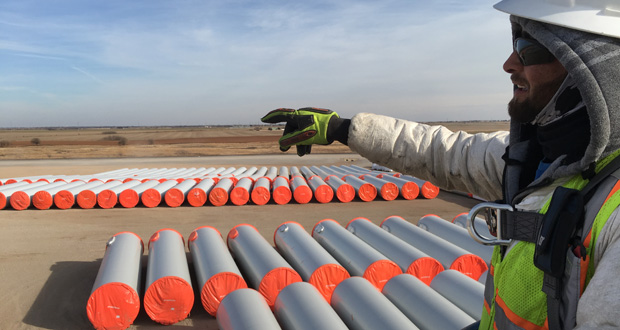Billy Brenton chose a less-than-ideal spot for his wind farm logistics company when he selected Enid.
Economic development staff members and city, county and state officials helped make the decision easy, said the vice president of Transportation Partners & Logistics Management Solutions. Officials helped expedite permits and surveys needed to complete the transaction, and offered $2.5 million to upgrade the access road to his site.
“Their willingness to bring me here changed everything,” Brenton said.
His $7 million facility on the edge of the city is a staging area for the blades, towers, nacelles and other components needed to build a wind farm. He turned a wheat field into a gravel yard, raising the elevation and extending railroad tracks to offload those parts. Wind component manufacturers send parts directly to him on rail cars, and then he provides the trucks to deliver pieces to developers building wind farms.
The Wyoming native came to Oklahoma to help NextEra build a wind farm near Rush Springs. He said he typically likes to build his sites within about 100 miles of a wind farm. He approached a landowner in Chickasha to build the facility, but the man turned him down.
So he turned to an associate who helped him build a successful logistics facility in Garden City, Kansas. The man had Enid connections and pointed him to people in the city.
Enid Regional Development Alliance Executive Director Brent Kisling said he trusted Brenton’s plan to develop the site because of the Kansas terminal. Site work had already been completed on the Enid land from previous plans for a canola plant that never materialized.
Brenton was able to complete the Kansas yard in a matter of months. His contractors laid 7,000 feet of railroad tracks in seven days, working nonstop.
Speed was of the essence, because parts manufacturer Vestas had to move components from the warehouse. If the company couldn’t move the inventory out of the Iowa-based manufacturing plant, workers couldn’t build any more parts, Brenton said. The company considered shuttering the plant.
What began as a 30-acre facility in Garden City has now grown to 600 acres, he said.
When Brenton arrived in Enid, Kisling had all the right people in the room: the county commissioner, city planners, engineers and the county assessor. The city contributed about $1 million for upgrading the road. And convincing Oklahoma Department of Transportation Secretary Mike Patterson to tap into the Industrial Access Road program wasn’t difficult, Brenton said.
Sixty-sixth Street is more potholes than road, so they took Patterson on a drive to the then-proposed site in a bus with no shocks. The ride was so rough, Patterson quickly agreed the project was worthwhile, Brenton said. ODOT is contributing $1.2 million from its industrial access road program. The bid should go out by the end of January.
Kisling said he understood that Brenton needed a quick turnaround to build the facility to keep TP&L’s customers happy.
“We can have all the best incentives in the world, but the time it takes to get the permit is the greatest incentive we can provide,” Kisling said.
Getting a guarantee to upgrade about 1 mile of road helped seal the deal, Kisling said.
Now Brenton has about $580 million in equipment at his facility, all of which is subject to ad valorem taxes. He has a four-year contract with NextEra Energy, which will take 20 percent of the parts stored on Brenton’s facility each year.
He has another contract with Vestas, in which his company will bring its parts to his yard in July and construction will begin in August. He has 30 employees now, all of whom used to work in the oil field, he said. He plans to hire 30 more in the summer.
He said he’s glad the city officials and regional development staff facilitated the process quickly so he could meet his customers’ needs.
“We would not have come here if the community didn’t come together and help with the project,” Brenton said.
Story provided by: Journal Record
Written by: Sarah Terry-Cobo


